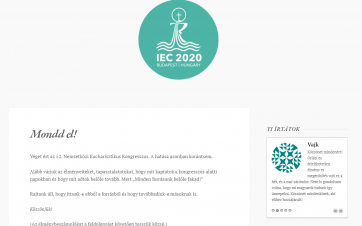
Heroes’ Square: Witness of great times

Heroes’ Square, one of the most photographed and eye-catching spots of Budapest, stretches out at the end of Andrássy Avenue. Several aspects determined the design of this iconic square: first of all the quick development of the city, then the construction of the Andrássy Avenue, -inspired by the Paris Champs-Élysées-, moreover the territory was marked for representative purposes, all topped with an approach aimed at strengthening the Hungarian national identity.
Progressive thinking
The idea for organising a series of millennial celebrations on the occasion of the thousand year anniversary of the Hungarian statehood in 1896 popped up in the mid- 19th century. Lengthy negotiations and discussions preceded the realization. By the time the 1892 Act was finally passed, declaring that “The National Exhibition to be held in Budapest”, the concept to set up a Millennial Monument had already emerged. However, this latter one received legal support only in 1896, and it took decades to complete the monumental group of sculptures.
Thirty years of construction
The Exhibition Hall (Museum of Contemporary Art) on Heroes’ Square was completed by 1896, right in time for the millennial celebrations. Further on, a decision was made for the construction of the Museum of Fine Arts and to set up a Millennial Monument, namely a group of sculptures to commemorate Hungary’s thousand years of statehood. However, this iconic statue complex, featuring the Seven Chieftains of the seven tribes of the Hungarians arriving into the Carpathian basin with Leader Árpád around 895 A.D, as well as the Heroes’ Memorial in front of the Millennial Monument, were completed by 1929 only.
The Prime Minister intervenes
Several tenders were called to design the square layout. Primary goal was to form an impressive endpoint to the Andrássy Avenue. There were even plans to place the equestrian statue of Count Gyula Andrássy in front of a semi-circular colonnade. Sándor Wekerle, Prime Minister had already made a proposal for the Monument complex, however, in 1894, he himself submitted some clarifications to speed up the construction process. A committee had been set up, who finally decided on commissioning Albert Schickedanz and György Zala to carry out the statue project. Prime Minister Wekerle personally invited the artists for the work. The original plan had been slightly modified, which was then accepted and approved by the Committee in charge, so the construction could begin in 1898.

Debate, debate, debate
By 1905, the built space of the square had been completed, however to set up all the statues proved to be a longer process, which was further delayed by the 1st World War as well. The birth of a national public pantheon triggered huge attention and debates. Disputes were on, who should and who should not have a place amongst our great ones. Finally in 1897 a list was approved for the statues to be placed into the niches of the two-winged semi-circular colonnade. As a result, the left colonnade would have given place to kings St. Stephen, St. Ladislaus, Coloman of Hungary, Andrew II., Béla IV., Charles Robert and Louis the Great, while in the right side one the statues of Matthias Hunyadi, John Szapolyai, Ferdinand I., Charles III., Leopold II., Maria Theresa and Franz Joseph would have been placed.
Artistic collaboration
Following some heated debates, finally instead of Szapolyai, the statue of John Hunyadi was placed, the only one not being a King in the row. At the inauguration of the built parts in 1905, statues of five historical figures were completed. Sculptor György Zala invited several brilliant artists, namely Richárd Füredi, Barnabás Holló, Miklós Köllő, György Kiss, Ede Margó, Károly Senyei, Ede Telcs, and György Vastagh junior, to take part in the work to realize the royal figures’ statues.
A statue beyond dispute
There was only one single figure of the Millennial Monument complex that avoided the approval fights. It was the 36 metres high Corinthian pillar, on top with the 5 metres high bronze figure of Archangel Gabriel, the statue that had won the Grand Prix of the 1900’ Paris World Exhibition. Behind the pillar there is an 85 metres wide and 13 metres high two-winged semi-circular colonnade, in the niches that of with 7-7 statues of Hungarian kings and leaders, while the reliefs below them figuring an important event of each one’s life. The gigantic complex includes a total of 26 statues. On the pedestal, surrounding the central column stands Árpád in the front, the leader of the Seven Chieftains, who are encircling him. The statue of Archangel Gabriel on top of the pillar holding St. Stephen’s Crown dominates the square. The top of the two-winged semi-circular colonnades are enriched with 4 allegorical figures, from far left to far right: the Labour and Welfare, War, Peace, Knowledge and Glory.
Ideologies and statue replacements
The turbulent years that followed the 1st World War brought fast changing ideas on whose statue could stay in the square and who should be removed and erased from people’s memory as per the current system’s ideology and decision. During the 133 days reign of the Hungarian Soviet Republic, the statues of the Habsburg rulers were taken away. On May 1, 1919 the whole complex was covered with red drapery. The Horthy era replaced the statues of the outcast Habsburgs, and the severely damaged Franz Joseph statue was reproduced by sculptor György Zala.
1938. Heroes’ Square in a new role
Following a three decades of construction work process, the impressive square was inaugurated on 26 May 1929. The first important event organised in this spacious location was the year of Saint Emeric of Hungary in 1930. The territory, bordered by the two Museums and the City Park, has been called Heroes’ Square since 1932. The year of 1938 brought enormous changes. In honour of the then International Eucharistic Congress the landscape area was paved, enabling the square to host grandiose mass events.

The redesign
The second half of the 20th century was characterised by demonstrations and political propagandistic events on this spacious location, fading more and more the national pantheon and the symbols of the thousand year statehood. The devastation of World War II also left its traces, the statues of Maria Theresa and Leopold II were destroyed during the battles. The figures of Árpád and the Seven Chieftains have been restored after 1945, while the statues of the Habsburg dynasty have been removed, and replaced by statues of Hungarian freedom-fighters. The then one-party system modified the history approach into a class conflict attitude, and this focus had to be reflected also by one of the most significant squares of the capital. In addition to the king statues authorized by the then regime, the statues of Imre Thököly, Ferenc Rákóczi II., and Lajos Kossuth were placed to the right side colonnade.
A location of cathartic events
Following World War II the square became the venue for demonstrating the power of the then regime. The May 1 parades took place here. In 1957, János Kádár gave his speech in Heroes’ Square, aiming to legitimize his power after the defeat of the 1956 uprising and nationwide revolution. At the time of the regime change, in June 1989 a huge crowd gathered at the square for the historic reburial of Imre Nagy and his comrades. This emblematic square had the honour to host the Holy Mass, celebrated by Saint Pope John Paul II in 1991.
Experience the historical moments!
September 12, this year Heroes’ Square will also be the site of an outstanding event. Pope Francis will celebrate here the Ceremonial Closing Mass of the 52nd International Eucharistic Congress. Further programs are to be held at this prominent location, including the Congress’ Opening Ceremony, and the Candlelight Procession of September 11, starting at Kossuth Square and ending here on Heroes’ Square.
Surf around the programs! Register and join us! Let’s celebrate together!










